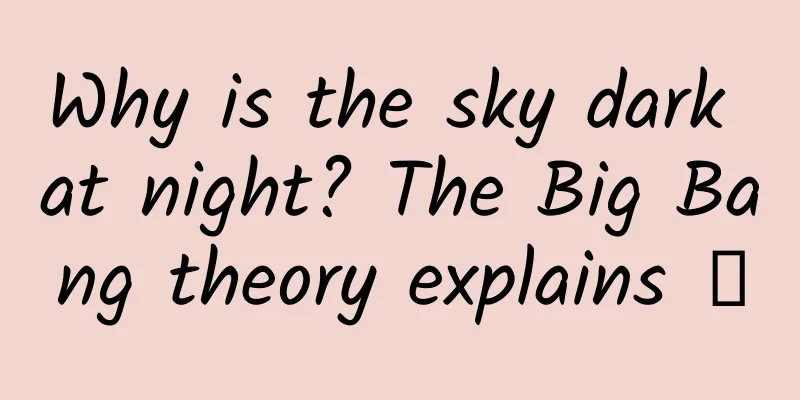Why is the sky dark at night? The Big Bang theory explains →

|
Author: Duan Yuechu and Huang Xianghong On a clear night, when we look up at the starry sky, we see stars twinkling in the deep darkness. We can't help but wonder: Why is the sky black at night? Astronomer and science communicator Phil Platt explored this question in depth. Before the 20th century, many astronomers firmly believed that the universe was "infinite in time and space, extending forever." They believed that the stars were like eternal guardians, always existing in the vast universe and never changing. Under this assumption, a confusing contradiction quietly emerged. If the universe is really infinite, then no matter where we look, our sight should eventually fall on a star. In this way, the sky should be lit up by endless starlight, just like daytime. However, the reality is not the case. The night sky is still dark. In 1929, Edwin Hubble made a major discovery that shocked the scientific community. He observed that the universe was not static, but was constantly expanding. This discovery was like a boulder dropped on a calm lake, completely breaking the previous cognition and paving the way for the Big Bang theory to flourish in the following decades. According to the Big Bang theory, the universe was born in a shocking explosion, and this great beginning was determined to be about 13.8 billion years ago. This means that the universe is not eternal, it has a clear starting point. In this new cosmic model, many factors work together to shape the dark sky we see at night. The expansion of the universe is like a giant stretcher, which increases the distance between galaxies. Light is gradually stretched during propagation, and energy is continuously lost, resulting in the so-called cosmic redshift phenomenon, which causes the light from distant stars to become extremely weak and difficult to illuminate the entire night sky. At the same time, the life of stars is limited, and they will die after their fuel is exhausted. As time goes by, the number of stars that can emit light gradually decreases, and the light of the universe also dims. The light emitted by those stars that are too far away from us has not yet reached the earth during its long journey, and has dissipated in the endless space. This contradiction between the darkness of the night sky and the assumption that the universe is infinite is called the Olbers paradox. It is named after the German astronomer Olbers, who wrote a paper exploring this issue in 1823. However, Olbers was not the first person to think about this problem. As early as the 16th century, British astronomer Thomas Diggs touched on this issue when he proposed the idea that the universe might be infinite. This paradox is like a fog that has troubled astronomers for centuries. In 1848, a famous American writer proposed a seemingly reasonable but unquantified solution in a paper, which brought new light to the Olbers paradox. As for who this writer was, Phil Platt left clues in his article, tempting readers to find the answer. This research result has far-reaching significance in the field of astronomy. It has prompted scientists to re-examine the nature of the universe, breaking the shackles of traditional concepts and promoting a huge leap in cosmological theory. From a broader scientific perspective, it makes us deeply realize that human understanding of the universe is an evolving process, and every breakthrough is accompanied by a subversion of existing cognition. As Lord Kelvin said: "There is no paradox in science. The so-called paradox is nothing more than an illusory conflict caused by our limited understanding." As we continue to explore the universe, the mysteries that once troubled us will eventually be solved one by one, and our understanding of the universe will reach new heights. Experts play a vital role in this exploration process. With their keen insight and rigorous scientific attitude, they continue to dig out new evidence and improve theoretical models. The development of the Big Bang theory is the result of the joint efforts of many scientists. From Hubble's observation to the in-depth analysis of countless researchers later, each step embodies the crystallization of human wisdom. The research of these experts not only allows us to understand the reason why the sky is dark at night, but also reveals to us the magnificent picture of the birth and evolution of the universe, inspiring our endless passion for exploring the mysteries of the universe. References: Why Is the Night Sky Dark? You Can Thank the Big Bang | Scientific American |
<<: Can I not wash my face when the weather is cold? The answer is unexpected →
>>: A baby saber-toothed tiger from 30,000 years ago was discovered! It still had whiskers and claws
Recommend
Shenzhou Special Car "bites" Uber: guessed the beginning but not the end
In order to make the headlines, Shenzhou Special ...
Baidu Information Flow | Advertisements with high click-through rates usually rely on these 3 points!
How to attract users' attention and stimulate...
Industrial design always shines; Chinese design leads the trend of home appliances in Europe and America
The change in the iPhone 6's appearance has o...
Is it not good to walk more than 10,000 steps a day? How many steps should we walk?
Many people shake their phones when they sit down...
Don’t be greedy for Yunnan mushrooms, these 6 kinds of mushrooms in supermarkets are also delicious and nutritious (with recipes included)
Since the beginning of human life, people have of...
Popular Science Illustrations | Technology empowers the protection of the Grand Canal to come alive!
...
Growth Hacker Methodology: How to find growth points?
Every team is pursuing growth, but how is growth ...
Shocking! A 2-year-old girl's intestinal flora imbalance caused her to self-harm. The reason behind it is shocking!
Recently, a 2-year-old girl named Xiaoxin from Ji...
Have you checked out these 9 kinds of autumn leaf trees this fall?
This fall, which popular tourist spots suitable f...
Get the most out of these 3 types of users and solve your promotion problems!
The categories of operations include data operati...
A must-see for newbies! How can an account with 0 followers sell goods through live streaming?
A few days ago, in an article about the practical...
"3D Game Engine Development" Graphics Theory Basics Tutorial Video
Video lecture content: Through learning, you can ...
The koi in the scenic area are as fat as balls. Don’t the fish feel full?
Audit expert: Wang Lei National Parks and Conserv...









